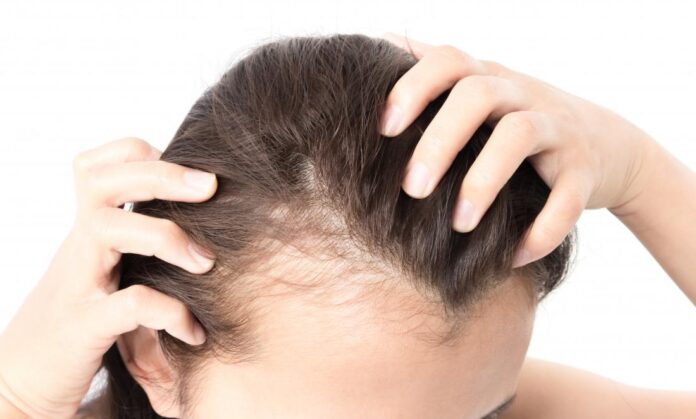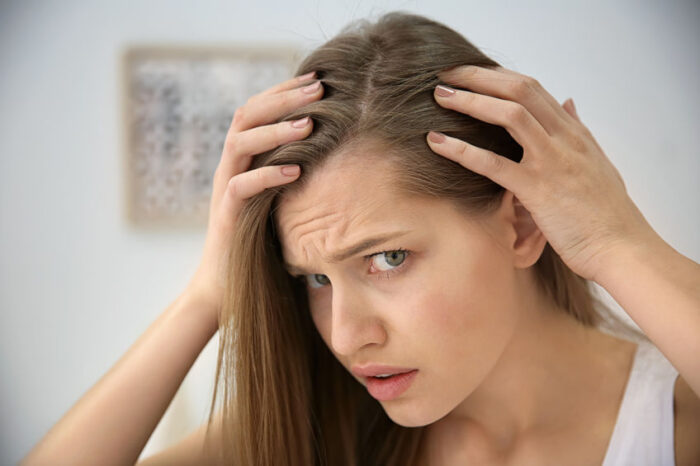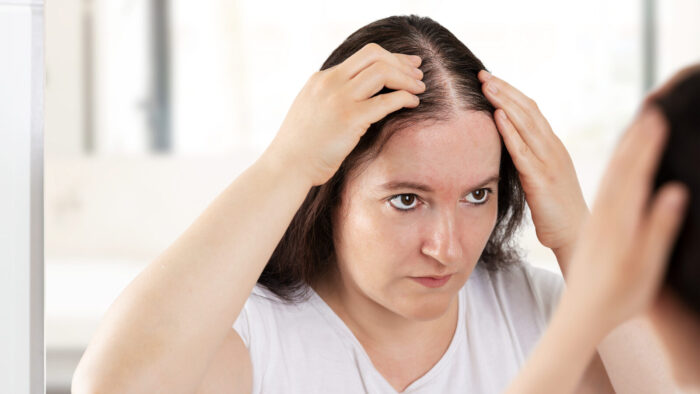
Hair loss can be a deeply distressing experience, particularly for women who often associate their hair with beauty, identity, and confidence. This comprehensive guide will explore the multifaceted issue of hair loss in women, encompassing its causes, types, and the diverse range of solutions available. Whether you’re seeking a better understanding of the condition, strategies for prevention, or effective solutions to address hair loss, this guide will provide in-depth insights to help you navigate this common concern.
What’s Hair Loss in Women?
Hair loss in women is a condition characterized by a decrease in hair density or volume, leading to noticeable thinning or balding. Unlike male pattern baldness, which follows a distinct pattern of receding hairlines and bald spots, female hair loss often occurs as diffuse thinning over the entire scalp. It’s essential to differentiate between normal hair shedding and excessive hair loss to determine whether intervention is necessary.
What Causes Hair Loss in Women?

Understanding the root causes of hair loss in women is pivotal to addressing the condition effectively. Several factors can contribute to hair loss, and these include:
- Androgenetic Alopecia: The most common cause of hair loss in both men and women, androgenetic alopecia is often referred to as female pattern hair loss. It is primarily related to genetic predisposition and hormonal influences. This condition can lead to the gradual miniaturization of hair follicles, resulting in thinner, shorter, and finer hair.
- Hormonal Changes: Hormonal fluctuations play a substantial role in female hair loss. Major life events, such as pregnancy, menopause, and the onset of conditions like polycystic ovary syndrome (PCOS), can disrupt the delicate hormonal balance. This disruption may lead to hair loss as a result of elevated levels of androgens (male hormones) or shifts in other hormonal patterns.
- Medical Conditions: Numerous underlying medical conditions can be associated with hair loss in women. Thyroid disorders, anemia, and autoimmune diseases can lead to hair thinning. In the case of autoimmune conditions like alopecia areata, the immune system mistakenly attacks the hair follicles, leading to hair loss in small, round patches.
- Stress and Lifestyle: Chronic stress, combined with unhealthy lifestyle choices, can contribute to hair loss. Poor nutrition, rapid weight loss, and harsh styling practices can weaken the hair shaft, causing breakage and shedding.
- Medications and Treatments: Some medications, including those used to manage conditions like cancer, depression, and hypertension, may have hair loss as a side effect. Additionally, radiation therapy and certain treatments like chemotherapy can lead to significant hair loss, often temporary in nature.
Hair Loss Prevention and Self-Care

Preventing hair loss and maintaining healthy hair is essential for women of all ages. While some causes of hair loss are beyond your control, adopting self-care practices and preventive measures can help promote hair health:
- Balanced Diet: Proper nutrition is key to hair health. Include foods rich in essential vitamins and minerals, such as biotin, iron, and zinc. Omega-3 fatty acids found in fish and nuts can also promote hair growth.
- Stress Management: Chronic stress can lead to hair loss, so it’s essential to manage stress through relaxation techniques, yoga, meditation, or engaging in stress-reduction activities that you enjoy.
- Gentle Hair Care: Avoid harsh hair care practices. Be gentle when brushing, and use a wide-toothed comb to prevent breakage. Limit the use of hot styling tools, and when you do use them, apply a heat protectant to your hair.
- Avoid Tight Hairstyles: Tight hairstyles such as ponytails, braids, or cornrows can lead to a type of hair loss called traction alopecia. Opt for looser styles to reduce the strain on your hair.
- Regular Scalp Care: A healthy scalp is crucial for healthy hair. Regularly cleanse your scalp to remove excess oil and buildup, but be gentle to avoid overstimulating the sebaceous glands.
- Avoid Smoking and Excessive Alcohol: Smoking and excessive alcohol consumption can contribute to hair loss. Quitting smoking and moderating alcohol intake can benefit not only your hair but also your overall health.
- Consult a Dermatologist: If you notice persistent or excessive hair loss, consult a dermatologist or healthcare provider. They can help diagnose the underlying cause and provide guidance on appropriate treatment options.
- Topical Hair Growth Products: Some over-the-counter and prescription topical products, such as minoxidil, may help promote hair growth and slow down hair loss. Consult a healthcare professional before using these products.
By incorporating these preventive measures into your daily routine and seeking professional guidance when needed, you can take proactive steps to maintain and promote hair health. Hair loss is a common concern, but it doesn’t have to define your self-image. With the right knowledge and care, you can continue to embrace your natural beauty and feel confident in every aspect of your life. Remember, you’re not alone in this journey, and there are resources and support available to guide you towards a solution that suits your unique needs and preferences.
Female Hair Loss Solutions

Addressing female hair loss is not a one-size-fits-all endeavor. Various solutions are available to accommodate individual needs and preferences:
Hair Toppers: Hair toppers are a non-invasive means of adding volume to thinning hair. These hairpieces are designed to cover specific areas of concern, providing natural-looking results. Hair toppers are versatile and can be securely attached with clips or tape, offering coverage where it’s needed most. They blend seamlessly with your natural hair, boosting volume and confidence.
Hair Extensions: Hair extensions are an excellent solution for women looking to achieve temporary added length and volume. These extensions are available in various styles and can be matched to your natural hair color. They are typically clipped, glued, or sewn into your existing hair, adding both length and volume. Hair extensions offer the freedom to experiment with different styles without the long-term commitment.
Wigs: Wigs are among the most versatile and comprehensive solutions for women experiencing severe hair loss. They are available in an array of styles, colors, and materials, including natural human hair and synthetic fibers, to cater to a wide range of preferences. Wigs come in different cap constructions, such as lace front, monofilament, and hand-tied, each offering specific benefits in terms of comfort and appearance. Wigs provide an option for women to completely transform their look or to retain a style that feels familiar and comfortable.
Conclusion
Hair loss in women can be a challenging and emotional journey, but it’s crucial to remember that there are effective solutions available. By understanding the causes, different types of hair loss, and the myriad of solutions at your disposal, you can take proactive steps to address this common concern. With knowledge, understanding, and the right approach, hair loss can be managed effectively, and you can embrace your natural beauty and confidence.
















